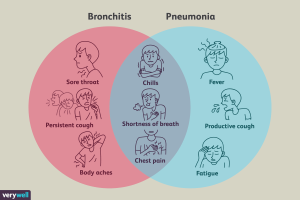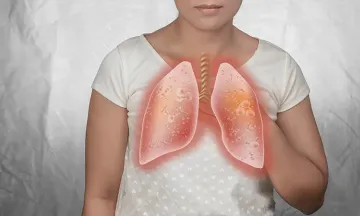Chest infections Chest infections, a prevalent occurrence, tend to follow a cold or flu, particularly during the autumn and winter months. While many cases are mild and resolve independently, some can present serious or even life-threatening complications. This comprehensive guide aims to provide an in-depth understanding of chest infections, covering symptoms, causes, home care strategies,
Chest infections
Chest infections, a prevalent occurrence, tend to follow a cold or flu, particularly during the autumn and winter months. While many cases are mild and resolve independently, some can present serious or even life-threatening complications. This comprehensive guide aims to provide an in-depth understanding of chest infections, covering symptoms, causes, home care strategies, and preventive measures.

Image by: www.topdoctors.co.uk
Unveiling the Symptomatic Landscape
Recognizing the signs and symptoms of a chest infection is paramount for timely intervention. The primary indicators include:
- Persistent cough: A recurring cough is a common manifestation.
- Coughing up colored phlegm: Yellow or green phlegm, and in severe cases, coughing up blood.
- Breathlessness and rapid breathing: Difficulty in breathing or an increased respiratory rate.
- Wheezing: A whistling sound during breathing.
- High temperature (fever): Elevated body temperature as a response to infection.
- Rapid heartbeat: An increased heart rate due to the body’s efforts to combat the infection.
- Chest pain or tightness: Discomfort in the chest region.
- Confusion and disorientation: Cognitive symptoms indicating a more severe infection.
In addition to these, individuals may experience more general symptoms, including headaches, fatigue, sweating, loss of appetite, and joint/muscle pain.

Image by: www.geeksforgeeks.org
Exploring the Roots: Causes of Chest Infections
Understanding the causes of chest infections is crucial for tailoring appropriate management strategies. The primary types of chest infections are bronchitis and pneumonia. Bronchitis is often viral, while pneumonia is commonly bacterial. Transmission occurs through respiratory droplets released when an infected person coughs or sneezes, making it an airborne contagion.

Image by: www.verywellhealth.com
Navigating Risk Groups
Certain groups of individuals are at a higher risk of developing serious chest infections. These include:
- Babies and young children
- Individuals with developmental problems
- People who are very overweight
- Elderly individuals
- Pregnant women
- Smokers
- Individuals with long-term health conditions
Understanding the vulnerability of these groups is vital for targeted preventive efforts and early intervention.

Image by: www.onlymyhealth.com
Holistic Home Care Approaches
While many chest infections resolve independently, adopting certain home care practices can enhance recovery. Consider the following tips:
Do:
- Prioritize rest: Allow your body the time it needs to recuperate.
- Stay hydrated: Fluid intake helps loosen mucus, making it easier to expel through coughing.
- Pain relief: Use paracetamol or ibuprofen to alleviate headaches, fever, and general aches and pains.
- Soothing remedies: A warm drink of honey and lemon can relieve a sore throat caused by persistent coughing.
- Elevate your head: Sleeping with extra pillows can facilitate easier breathing.
- Quit smoking: For smokers, discontinuing smoking is integral to recovery.
Avoid:
- Cough medicines: Limited evidence supports their efficacy in expediting recovery.
Navigating When to Seek Professional Guidance
While home care is effective for most cases, knowing when to seek medical attention is crucial. Contact your GP if:
- Severe symptoms persist
- Confusion, disorientation, or drowsiness occurs
- Coughing up blood or experiencing chest pain
- Skin/lips develop a blue tinge (cyanosis)
- Pregnant, aged 65 or over, very overweight, or with weakened immunity
Preventive Measures: Beyond the Infection Horizon
Reducing the risk of chest infections involves adopting preventive measures:
- Quitting smoking: A pivotal step in fortifying lung health.
- Practicing good hygiene: Cover your mouth when coughing or sneezing, and maintain regular handwashing.
- Limiting alcohol consumption: Excessive and prolonged alcohol misuse weakens natural defenses against infections.
- Maintaining a healthy diet: A balanced diet strengthens the immune system.
- Considering vaccinations: Individuals at increased risk may benefit from flu and pneumococcal vaccinations.

Image by: www.linkedin.com
Conclusion
In the realm of chest infections, awareness and proactive health measures emerge as powerful tools for both prevention and management. This comprehensive exploration has delved into the intricate facets of chest infections, ranging from their symptomatic manifestations to the roots of their causation.
Understanding the diverse symptoms, including persistent coughs, breathlessness, and chest pain, equips individuals to recognize potential chest infections early on. The differentiation between bronchitis and pneumonia, with their distinct viral and bacterial origins, lays the foundation for targeted interventions.
Acknowledging the vulnerability of specific groups, such as the elderly, pregnant women, and individuals with pre-existing health conditions, underscores the importance of tailored preventive strategies and timely medical attention when needed.





















Leave a Comment
Your email address will not be published. Required fields are marked with *